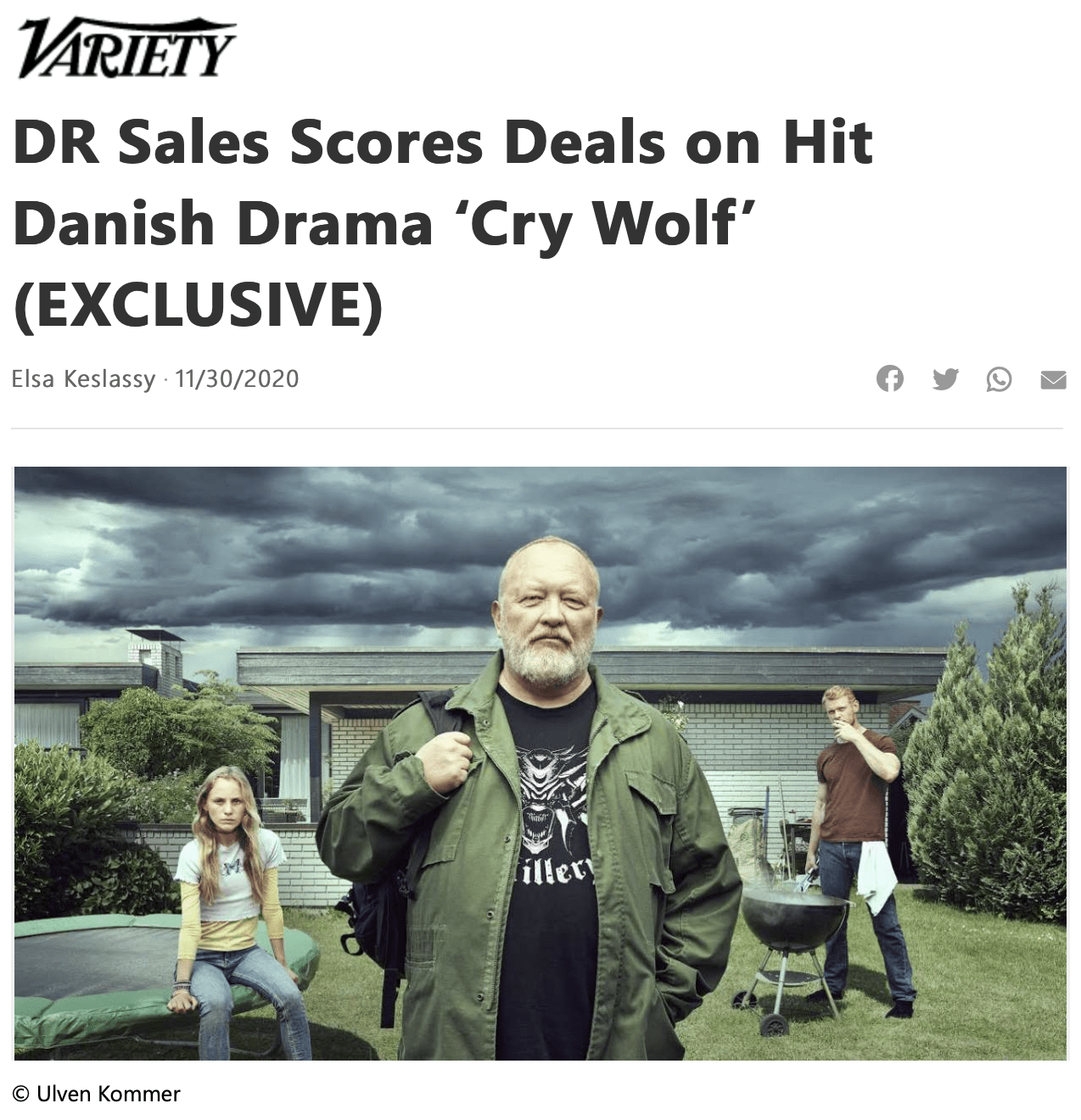There used to be a time when the only place to learn how to write for Danish film and television was the National Film School of Denmark (NFSD) that currently accepts six screenwriters for the 4-year programme every second year. The NFSD is an art school under the Danish Ministry of Culture and was established in 1966 with a focus on film as an artistic medium. For many years, there was no official teaching of screenwriting at the School. This only became an integrated part of the curriculum in the 1980s, and gradually the NFSD included screenwriting for television as well as for film (Redvall 2010, 2015).

Fig. 1: Maja Jul Larsen’s Ulven kommer/Cry Wolf is the latest DR serial drama by screenwriting alumni from the NFSD to travel to the UK. Screenshot from Variety.
Since the establishment of a screenwriting programme of its own, graduates have counted names such as Søren Sveistrup (Forbrydelsen/The Killing), Maya Ilsøe (Arvingerne/The Legacy) or Borgen writers Jeppe Gjervig Gram (Bedrag/Follow the Money) and Tobias Lindholm (most recently Efterforskningen/The Investigation, shown on BBC 2 in January). Because of this, previous Head of Drama at the Danish Broadcasting Corporation (DR), Piv Bernth, has called the television screenwriting term at the NFSD (where students try their hands at developing potential series) one of ‘the secrets’ behind the past years’ success of Danish television drama (in Redvall 2013: 17).
How many screenwriters does a small nation television industry need?
This year there were 157 applicants for the six places as screenwriting students starting at the NFSD after the summer (Christensen 2021). The number illustrates how many young people dream of a career in film and television screenwriting, and there are no other similar long-term training grounds in Denmark, but some alternative offers. In the 2010s, the independent film collective Super16 started including screenwriting in their self-organised teaching, the University of Southern Denmark launched an elective programme for screenplay development and there have also been shorter screenwriting courses for many years at Kort- og Dokumentarfilmskolen (‘The short and documentary film school’, https://filmkurser.dk).

Fig. 2: This year saw a record-breaking number of applicants for the NFSD with 781 people wanting to be among the 48 students chosen for the School’s eight different programmes (Christensen 2021). Screenshot from the website of the NFSD, filmskolen.dk.
In the past years, several industry players have suggested educating more screenwriting talent since they find that there is a greater demand for writers when national productions are now no longer only targeted at national cinemas and broadcasters but also at international SVOD players looking to produce ‘original series’ in local markets. There have been many discussions of the number of people who can have sustainable and continuous careers in the media industries in relation to how many people to train (not the least during a pandemic…), but this year several industry players seem tired of waiting for more training opportunities and have taken matters into their own hands.
New talent programmes for writing serial television
The production company Drive Studios launched a “screenwriting talent programme”, Drive Writing Studio, in January 2021 to “meet the growing demand for fiction, in both the Danish and foreign markets”. This initiative will be discussed as part of a free English-language seminar on television writing and writers’ rooms on 25 March that also includes a masterclass session with Borgen showrunner Adam Price, an interview with screenwriter Maja Jul Larsen (writer of Ulven kommer/Cry Wolf which was just picked up by Channel 4’s Walter Presents) and French screenwriter Arnaud Malherbe (ARTE’s thriller Moloch) (https://thisaarhus.com/speaker/writers-room/).

Fig. 3: The Masterclass on writers’ rooms organised by THIS on 25 March will, among other things, present the two new screenwriting initiatives Drive Writing Studio and Serieskolen. Screenshot from thisaarhus.com.
The seminar will also discuss ‘Serieskolen’ (‘The Series School’) which is a new and somewhat surprising training initiative established in a collaboration between Netflix and the state-subsidised Film Workshops. Serieskolen promises a focused course on developing a new idea for a TV series, leading up to three ideas/teams getting 100.000 DKK and access to professional equipment to produce a 15-minute pilot episode.
The recurring tensions between art and craft in film education
Drive Writing Studio and Serieskolen mark a new tendency for industry players to get actively involved in training talent for the specific kind of content that they want to produce. Traditional broadcasters have previously had inhouse talent workshops with different outlooks, but it is the first time that an international SVOD, such as Netflix, engages in educational programmes in the national screen industry.
So far, there has generally been a favourable response with Head of the Danish Directors Guild, Christina Rosendahl, welcoming new opportunities for film and television education. However, she also raises concerns about issues of IP when talent is suddenly being trained by specific industry partners who might own the rights to their ideas in the process (in Monggaard 2021).

Fig. 4: According to the Danish Writers Guild, the current boom in TV series has led to a need for clarification around how screenwriters should be credited. The guild thus recently presented a new folder with suggestions about this from the union perspective. Screenshot of the front page from dramatiker.dk.
As discussed in scholarly literature on film education, the 2000s have seen still more tensions between thinking of film schools as primarily art schools or as places where people learn a craft and specific skills needed in the screen industries (e.g. Petrie, 2010, 2011; Petrie and Stoneman, 2014). The recent developments in the training landscape for Danish television screenwriting point to how new (short-term) schemes are now focused on very specific kinds of content and formats. This also relates to focusing on very particular audiences, such as children.
Teaching writing for children as cross-media and co-creative
In the Researching Young Audiences (RYA) research project we currently follow the first years of the new ‘Manuskriptskolen for børnefiktion’ (The Cross Media School of Children’s Fiction) established in 2020 by Elin Algreen-Petersen and Dennis Glintborg. The Copenhagen-based school offers a 2-year part-time programme financed by a mix of public and private funds and partners.

Fig. 5: Manuskriptskolen for børnefiktion (The Cross Media School of Children’s Fiction) was launched in 2020 and focuses on teaching world-building and storytelling for children across different media and platforms. Image from www.manuskriptskolen.dk, courtesy of The Cross Media School of Children’s Fiction.
Besides the fact that there is now an educational offer that focuses specifically on creating content for children and young audiences, an interesting aspect of the curriculum is the cross-media outset for teaching. The school accepts 12 students a year who go through six main modules with the titles: ‘world-building’, ‘storytelling’, ‘impressions and expressions’, ‘the life-worlds of children and young audiences’ and ‘media forms’ followed by a ‘final project’ where students spend the fourth and final term developing their own project.
All teaching is based on students working with world-building and storytelling for books, film, television, theatre, games or a combination of these. Working with different media or across media is thus a precondition from the outset rather than an add-on that students might consider once they have learned the craft of developing stories for a particular medium, as is the case in most schools focusing on working with, for instance, specifically literature or film. Manuskriptskolen also insists that storytellers targeting children need to engage with children of today and encourages working with co-creation with children in different forms.
In the RYA project we study how this is done and look forward to seeing the first final projects. Where people train for an industry and what they are taught matter, and it is refreshing to see children and young audiences being taken seriously as a specific audience in the current educational landscape for the Danish screen industries.
Eva Novrup Redvall is Associate Professor at the University of Copenhagen where she is head of the Section for Film Studies and Creative Media Industries and principal investigator of the RYA research project. https://comm.ku.dk/staff/?pure=en%2Fpersons%2Feva-novrup-redvall(fc809983-e37f-4f44-b71a-a0b1d36295b9).html
References
Christensen, Claus. 2021. ”Rekordmange ansøgere til Filmskolen.” Ekkofilm.dk, 22 February. https://ekkofilm.dk/artikler/filmskolen-optager-elever/
Monggaard, Christian. 2021. ”Hvis Netflix overtager talentudvikling, skal vi kigge på armslængde.” Information, 9 February.
Petrie, Duncan. 2010. “Theory, Practice and the Significance of Film Schools.” Scandia, 76:2, pp. 31–46. http://journals.lub.lu.se/index.php/scandia/article/view/5083/4534
Petrie, Duncan. 2011. “Theory/Practice and the British Film Conservatoire.” Journal of Media Practice, 12:2, pp. 125–138. https://doi.org/10.1386/jmpr.12.2.125_3
Petrie, Duncan and Rod Stoneman. 2014. Educating Film-Makers: Past, Present and Future. Bristol: Intellect Press.
Redvall, Eva Novrup. 2010. “Teaching Screenwriting in a Time of Storytelling Blindness: The Meeting of the Auteur and the Screenwriting Tradition in Danish Film-Making.” Journal of Screenwriting, 1:1, pp. 57–79. https://doi.org/10.1386/josc.1.1.59/1
Redvall, Eva Novrup. 2013. Writing and Producing Television Drama in Denmark: From The Kingdom to The Killing. Basingstoke: Palgrave Macmillan.
Redvall, Eva Novrup. 2015. “Craft, Creativity, Collaboration, and Connections: Educating Talent for Danish Television Drama Production.” In Miranda Banks, Bridget Conor and Vicki Mayer (eds): Production Studies, The Sequel! Basingstoke: Palgrave Macmillan, pp. 75–88.





